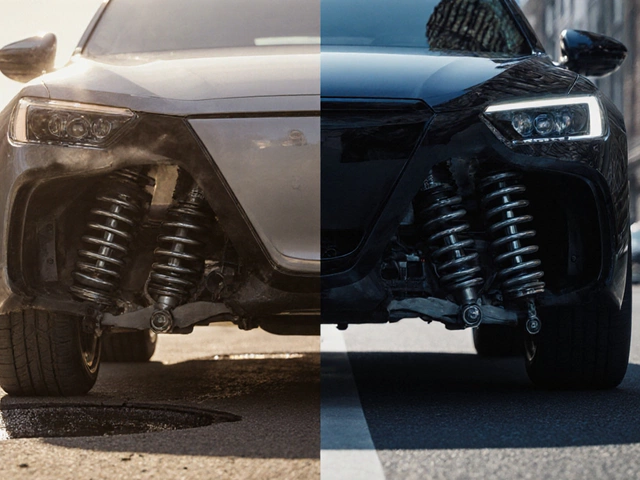Ever popped your hood and wondered if that radiator is still a thing in today’s high-tech cars? You’re not alone. A lot of people think car radiators went the way of cassette players, but that’s not the case for most vehicles on the road in 2025.
Here’s the quick answer: yes, most cars still have radiators, and you’d notice fast if they didn’t. Whether you’ve got a classic gas-guzzler, a modern hybrid, or even some electric rides, some kind of radiator is usually tucked in there to keep things from overheating. Try driving in stop-and-go traffic on a hot day without one, and you’d be the guy waiting for a tow truck way too often.
Why does this matter? Overheating is one of the main killers of engines. Fixing a cooked engine isn’t cheap. A working radiator is what stands between a healthy motor and a bill that makes your wallet cry. So, knowing a bit about radiators—how they work now, what’s changed, and what to look out for—can save you money and major headaches.
- What's the Job of a Car Radiator?
- Do Modern Cars Still Use Radiators?
- How Radiators Have Changed
- Electric Cars and Radiators: The Exceptions
- Tips for Keeping Your Cooling System Healthy
What's the Job of a Car Radiator?
If you cut through all the jargon, a car radiator is basically your engine’s bodyguard against heat stroke. The engine creates a ton of heat every time it runs. Without something to move that heat away, metal parts would warp or just plain melt, and that’s when you’d need a new engine. The car radiator takes the heat your engine spits out and cools it down before things have a chance to go wrong.
Here’s a super simple breakdown of how it actually works:
- The engine heats up coolant (a mix of water and antifreeze) as it runs.
- The hot coolant gets pumped into the radiator, which sits at the front of your car so it catches all the passing air.
- As air blows over the thin metal fins of the radiator, it cools down the coolant inside.
- The now-cooler fluid gets sent back to the engine, ready to grab more heat. This cycle keeps going as long as your car’s running.
That’s pretty much it—no magic tricks, just basic science. A cooling system with a solid radiator means the difference between a healthy engine and breaking down on the side of the highway.
"A healthy cooling system is critical if you want your car to last. Most engine failures are caused by overheating, which a good radiator is there to prevent," says John Ibbotson, Chief Mechanic at Consumer Reports.
The numbers really tell the story. A typical engine runs best around 195-220°F (90-105°C). Let it run hotter, and sooner or later, expensive damage shows up. So, if you’re driving any “normal” car, keeping your car radiator in good shape is non-negotiable if you want to avoid some steep repair bills.
Do Modern Cars Still Use Radiators?
Let’s clear up the rumors: the answer is yes—modern cars still use car radiators. The basic science hasn't changed much since grandpa’s Buick. Engines burn fuel, which creates a ton of heat, and that heat has to go somewhere. The cooling system—with the radiator at the heart—takes that job seriously. Pop the hood on a 2025 sedan, pickup, or SUV, and you’ll find a radiator sitting right up front, doing its thing every time you drive.
Even with all the tech upgrades—hybrid systems, turbos, even stop/start engines—most cars need a radiator to pull heat away from the engine. In fact, the need for cooling is even greater nowadays. Turbochargers and high-efficiency setups push engines harder and pack more components into smaller spaces, so those systems get hot, fast.
Here’s something a lot of people miss: most hybrids, and even plug-in hybrids like the latest Toyota Prius Prime or Ford Escape Hybrid, still use a radiator to cool both the gas engine and sometimes the battery pack. These setups even have extra cooling loops and compact radiator designs to handle the extra loads.
Take a look at what you’ll find under the hoods of current popular models:
| Vehicle Type | Radiator Present? | Notes |
|---|---|---|
| Gasoline Car (e.g., Honda Accord) | Yes | Traditional radiator for engine cooling |
| Hybrid (e.g., Toyota RAV4 Hybrid) | Yes | One for engine, sometimes extra for battery |
| Plug-in Hybrid (e.g., Hyundai Ioniq Plug-in) | Yes | Multiple cooling loops |
| Standard Electric Vehicle (e.g., Tesla Model 3) | Yes | Radiators cool battery and motors |
| Air-cooled Electric Scooter | No | Too small, air cooling is enough |
The main exceptions you’ll see are small, low-power electric vehicles, like some scooters or microcars, where air cooling is enough. But modern car radiators are still everywhere—just adapted and sometimes hidden better than before.
So, if you’re driving anything newer than 2010 that isn’t a pure city EV or tiny commuter, your car almost definitely relies on a radiator. Skip out on routine coolant checks or ignore a small leak, and you’re tempting fate. The radiator’s still doing most of the heavy lifting for your engine’s health, even in 2025.

How Radiators Have Changed
Radiators are a lot tougher and smarter than they used to be. Back in the day, radiators were big, heavy, and made almost entirely out of brass or copper. Those older materials did a decent job of pulling heat out of the coolant, but they were pricey and heavy. Fast forward to today, and most car radiators are built using lightweight aluminum. Aluminum radiators cost less to make and shed heat faster, which is exactly what modern engines need.
Another big shift? The design itself. Older radiators used a downflow setup, where coolant dropped down through vertical tubes. Modern radiators mostly use a crossflow design, moving coolant sideways across the car's front. This boosts cooling efficiency and gives designers more options for engine shape and size. With turbos, smaller engine bays, and hybrids being so common these days, that flexibility matters.
And don’t forget the tech. Years ago, fans that pulled air over your radiator were powered by the engine. Now, electric fans are standard because they can fire up exactly when they're needed, even if the car’s stopped. That’s a big win for cooling in city traffic or when you're idling with the AC blasting.
Modern engines also run hotter for better fuel efficiency and emissions, so radiators and their coolants have leveled up. Today's coolants last longer—some formulas go 100,000 miles before needing a change. Radiator caps even work differently, holding higher pressures to raise the boiling point of the coolant.
Check out the difference between old and new radiator materials in this simple table:
| Era | Typical Material | Pros | Cons |
|---|---|---|---|
| 1970s-1990s | Brass/Copper | Great cooling, easy to repair | Heavy, expensive |
| 2000s-present | Aluminum/Plastic | Lightweight, cheap, faster heat loss | Cracks easier, not as easy to fix |
So, if you’re eyeing a modern radiator, remember this: they may look simple, but they’re way more efficient, lighter, and built for today’s engines. Upgrading or even just flushing your cooling system on schedule is one of the cheapest ways to keep your ride happy.
Electric Cars and Radiators: The Exceptions
You might assume electric vehicles (EVs) dodged the whole car radiators game. They don’t have big gas engines, right? Turns out, many EVs still use radiators—but for a different reason. Instead of cooling a roaring engine, their radiators handle heat from batteries, electric motors, and sometimes the onboard chargers.
For example, look at the Tesla Model 3. Pop the frunk and you’ll spot at least one radiator tucked in front. It’s there to manage heat when you’re zipping down the highway or supercharging. If those battery packs get too toasty, performance drops fast, or worse, you could see system errors. The Chevrolet Bolt and Ford Mustang Mach-E have similar setups—liquid cooling running through radiators.
Some smaller, short-range EVs (think bargain city cars or golf carts) might skip the radiator and use air cooling or just big metal plates. Most real-world EVs meant for highway driving and fast charging? They need a radiator so stuff doesn’t cook.
Let’s put it into perspective with a quick table:
| Car Model | Type of Cooling | Has Radiator? |
|---|---|---|
| Tesla Model Y | Liquid (Radiator) | Yes |
| Nissan Leaf (Gen 1) | Air | No |
| Chevy Bolt | Liquid (Radiator) | Yes |
| Renault Twizy | Air | No |
| Ford Mustang Mach-E | Liquid (Radiator) | Yes |
EV cooling systems are usually less complex than gas engine ones, but they’re just as critical. If you drive an EV, don’t ignore those low coolant warnings. You can’t coast by like you might have with old-school air-cooled engines. Most modern cars, even electric, are still in the radiator club—just for reasons most people haven’t thought about.

Tips for Keeping Your Cooling System Healthy
Keeping your car radiator in good shape isn't rocket science, but skipping the basics can land you with a busted engine or a frying-hot commute. Most problems start off small and spiral when ignored. Here’s what you can do to keep things running smooth.
- Check Coolant Levels Regularly: This one’s simple. Make a habit of looking at your coolant once a month or before long trips. If it’s low, top it off with the right mix—usually 50/50 coolant and water for most modern cars.
- Look Out for Leaks: If you spot green, orange, or pink puddles under your car, there’s a good chance it’s coolant. Don’t brush it off—leaks often mean there’s a bad hose, a cracked radiator, or even a busted water pump. Get it seen before tiny drips turn into pricey repairs.
- Flush Your Radiator: Most carmakers suggest flushing the cooling system every 2-5 years. Old coolant turns corrosive and can gunk up the engine. The owner's manual will have the right timing for your model.
- Check Hoses and Belts: Squeeze your hoses when the engine’s cool. If they feel spongy, brittle, or you see cracks, swap them out. Same goes for belts—no one wants a snapped belt on the way to work.
- Look at the Radiator Cap: This little guy holds pressure so the system works right. If the seal is torn or the spring’s weak, it can cause overheating even if the radiator itself is fine.
- Keep the Radiator Clean: Dirt, bugs, and leaves get stuck on the front and block airflow. A quick hose-down (when the engine is cold!) helps the system cool better, especially in hot weather.
Want to see how fast a small problem can grow? Here’s what a national survey of auto repair shops saw just last year with cooling system issues:
| Problem | Average Repair Cost |
|---|---|
| Low Coolant | $50 (just coolant top-off) |
| Hose/Clamp Leak | $120 |
| Bad Water Pump | $550 |
| Busted Radiator | $900+ |
| Blown Head Gasket* | $1,700+ |
*Usually caused by letting an overheating engine go too long unchecked.
Bottom line: don’t let your car radiator or cooling system run unchecked. Small fixes today save you a pile of money—and a tow—tomorrow.






